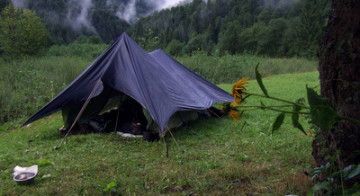Being in excellent shape before you start a backpacking trip makes a big difference in how much you enjoy your vacation. In contrast to out-of-shape hikers, physically fit hikers enjoy the scenery more, get injured less frequently, and even see more wildlife (because they’re alert and quieter).
On the Wonderland Trail, the average hiker will cover the 93 mile trail in 10 days. The trail’s default state is climbing or descending, and most hikers would consider most sections of the trail to be challenging. For many hikers this is a big jump in activity from their daily lives. This makes training before the trip essential for enjoyment and safety.
When building up your strength and endurance, take it nice and slow.
The key to any training program is to increase your daily exercise very gradually.
Increasing your daily exercise too quickly puts you at a high risk of injuries that could derail your training program by preventing you from exercising for weeks or even months.
A good rule of thumb is to increase the number of miles that you walk, run or hike by no more than 10 percent a week.
For example, if I run a total of 20 miles this week, I should run no more than 20+0.10×20=22 miles next week. My running partner usually ignores this rule (it is pretty hard to follow if you are excited about an activity!) and I frequently have to run alone while he nurses injuries.
Training for backpacking? Exercise sometimes wearing a backpack.
When preparing for a long backpacking trip like the Wonderland Trail, the core elements of a good training program are progressively longer hikes with a backpack to develop strength and balance and vigorous daily exercise to develop physical endurance.
Hiking with a backpack is an essential part of a good training program for obvious reasons.
Carrying a backpack over rough terrain uses your core, leg, and foot muscles for balance in a way that everyday locomotion does not.
A training program that includes many day hikes and at least two 3-5 day backpacking trips will strengthen your muscles and turn you into a sure footed mule.
Endurance, not just strength is important for backpacking.
Being fit for the trail is not just about strength and balance however. Hiking trails like the Wonderland Trail requires significant physical endurance.
Long before you leave for the trail, teach your body to expect heavy exercise many days in a row.
While daily backpacking would be the ideal way to prepare for your trip, backpacking is not always convenient. No matter — there are many ways to improve your endurance. Cycling, swimming, running and playing sports can all improve your endurance. Find an activity you like and gradually increase the number of days you exercise and the amount of exercise you do each day. Before you are ready to hike the trail you should be comfortable exercising vigorously for an hour or more at least five days a week.
Whatever your choice of vigorous exercise, it should be more difficult than hiking with a backpack– remember you are only training for an hour (or a few hours) each day, but you are planning to hike for 6-10 hours each day – make up for the shortened time with increased intensity.
A good exercise target in preparation for long-distance backpacking is a vigorous daily routine plus weekend hiking.
If you exercise vigorously for an hour or more each day and hike and backpack on the weekends you should be comfortable taking on a long-distance hike like the Wonderland Trail. This is the minimum required for an enjoyable trip however. If this is all you do, expect to be tired and sore for the first few days of your trip. By the fourth day of backpacking, your body will begin to adjust to the increased workload and you will start feeling stronger and more energetic.
How my exercise routine fared the first time I hiked the Wonderland Trail
Before I hiked the Wonderland Trail the first time, I ran around six miles most days on relatively flat terrain. I walked and biked and had a moderately active lifestyle and I went on a few three-day backpacking trips. I was sore and tired the first few days on the trail but by the end of the trip my pack felt light and my step was high.
Out of shape with little time to do anything about it?
If your trip is fast approaching and, despite your good intentions, you are not in as good of shape as you should be there are two things you can do. First, call the Wilderness Information Center and see if they can adjust your campsite reservations to accommodate lower mileage days and even days-off mid trip.
Secondly, take a serious look at what is in your pack. Reducing your pack weight will reduce the strength and endurance required to complete your daily hikes.


